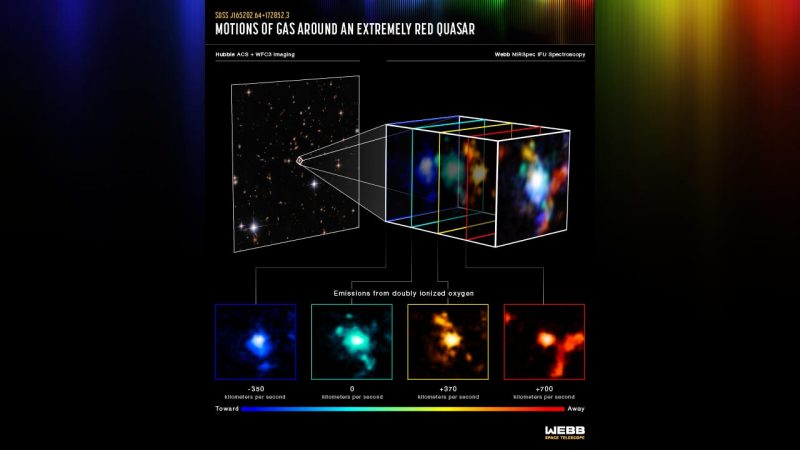A cluster of massive galaxies that are growing around a brightly red quasar has been discovered by astronomers investigating the early cosmos with NASA’s James Webb Space Telescope.
The findings will increase our understanding of how galaxy clusters in the early universe combined and produced the cosmic web we see today.
What Is This Galactic Active Nucleus (AGN)?
A specific type of active galactic nucleus known as a quasar is a small region containing a supermassive black hole at its center (AGN). Due to gas collapsing into a supermassive black hole, the quasar is so bright that it outshines all of the galaxy’s stars.
There was a quasar called SDSS J165202.64+172852.3 11.5 billion years ago. It is not only inherently red, but the light from the galaxy has also been particularly reddened by the galaxy’s enormous distance. As a result, Webb, who has the highest infrared sensitivity, was the best choice to thoroughly examine the galaxy.
Relevance Of This Galaxy’s Nucleus
This quasar is one of the most powerful galactic nuclei ever seen at such a considerable distance. The high emission from the quasar was thought to cause a “galactic wind” that would drive free gas from its host galaxy and possibly have a significant effect on future star formation.
The Near Infrared Spectrograph on the telescope was employed by the researchers to examine the movement of the galaxy’s gas, dust, and star material (NIRSpec). This advanced instrument uses spectroscopy to study the motion of several outflows and winds that surround the quasar.
NIRSpec can gather spectra from the whole telescope’s field of view, allowing Webb to examine the quasar, its galaxy, and the surrounding area all at once rather than just one area at a time.
Monitoring the Movements of the Environment’s Materials
Prior observations of the quasar’s powerful discharges by NASA’s Hubble Space Telescope and other observatories led astronomers to hypothesise that its host galaxy might be merging with an unknown companion.
The researchers did not, however, expect Webb’s NIRSpec data to reveal that there were, in fact, at least three other galaxies around the central galaxy in addition to the original one.
The red quasar was found to be a part of a tight knot of galaxy formation thanks to spectra that covered a large area that allowed the motions of all this surrounding material to be monitored.
“Few galaxy proto clusters are recognised at this early stage.” Stephen Webb and Dominika Wylezalek from Heidelberg University in Germany jointly led the study. “They are few and have had little opportunity to form since the big bang, according to Wylezalek. This might someday help us comprehend how galaxies evolve in dense environments. It’s a positive result.”
Quasar’s Three Galactic Companions
Using the NIRSpec photos, the team was able to prove the existence of three galactic partners to this quasar and show how they are related. According to Hubble archived data, there could be a lot more.
Due to Hubble’s Wide Field Camera 3 photos showing extended material encircling the quasar and its galaxy, the quasar was chosen for this study of its outflow and the effects it has on its host galaxy.
The team now thinks they may have been looking at the centre of a large galaxy cluster, which Webb’s precise photography has only lately made visible.
“According to team member Andrey Vayner of Johns Hopkins University in Baltimore, Maryland, “we quickly recognised from our initial examination of the data that there had been considerable interactions with the surrounding galaxies.” Infrared spectroscopy is entering a new era, and the NIRSpec device’s sensitivity was immediately apparent.”
The Early Cosmos’ Densest Areas of Galaxy Formation
There must be a lot of mass present for the three verified galaxies to be orbiting one another at such high speeds. Because of how closely they are concentrated in the region surrounding this quasar, the team believes that this is one of the densest known sites of galaxy formation in the early cosmos.
Wylezalek asserts that it cannot be explained by even a tightly bound dark matter knot. We think we might be watching a region where two massive dark matter halos are merging. Galaxies and galaxy clusters are thought to be held together by dark matter, an unobservable component of the cosmos, which creates a “halo” around these stars.
Conclusion
The study conducted by Wylezalek’s group is a part of Webb’s investigation into the early universe. Thanks to the telescope’s unparalleled ability to look back in time, researchers are already using it to examine how the first galaxies developed and changed, as well as how black holes appeared and changed the universe’s structure.
The researchers are planning additional studies into this intriguing galaxy proto-cluster to learn more about how dense, chaotic galaxy clusters like this one arise and how the active, supermassive black hole at their centre influences them.
The Astrophysical Journal Letters will publish these findings. This research was carried out as a part of Webb’s Early Release Science programme.
